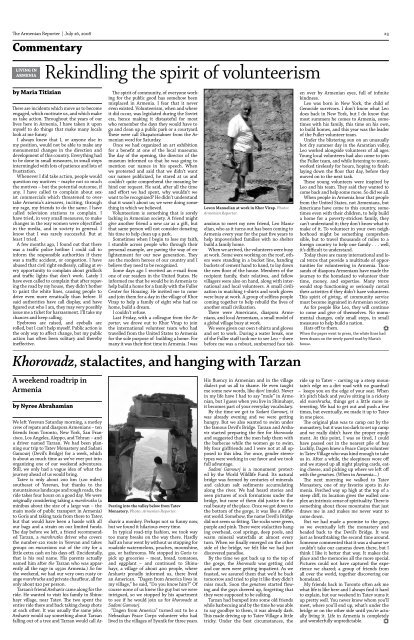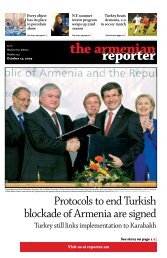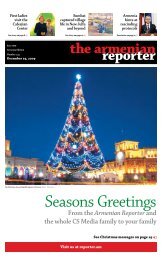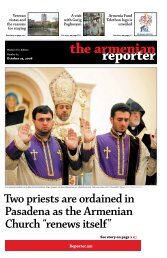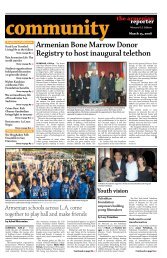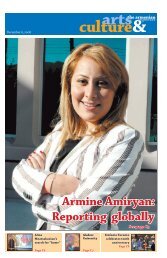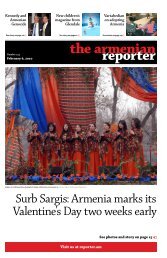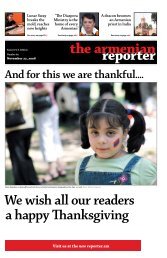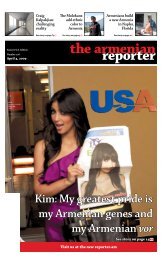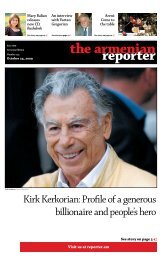responses - Armenian Reporter
responses - Armenian Reporter
responses - Armenian Reporter
- No tags were found...
Create successful ePaper yourself
Turn your PDF publications into a flip-book with our unique Google optimized e-Paper software.
The <strong>Armenian</strong> <strong>Reporter</strong> | July 26, 2008 23CommentaryLiving inArmeniaRekindling the spirit of volunteerismby Maria TitizianThere are incidents which move us to becomeengaged, which motivate us, and which makeus take action. Throughout the years of ourlives here in Armenia, I have taken it uponmyself to do things that make many localslook at me funny.I always knew that I, or anyone else inmy position, would not be able to make anymonumental changes in the direction anddevelopment of this country. Everything hadto be done in small measures, in small stepsintermingled with lots of patience and lots offrustration.Whenever I did take action, people wouldquestion my motives – maybe not so muchthe motives – but the potential outcome, ifany. I have called to complain about sexistcommercials which threatened to overtakeArmenia’s airwaves, inciting, throughmy rage, my friends to do the same. I havecalled television stations to complain. Ihave tried, in very small measures, to makechanges in the way women were objectifiedin the media, and in society in general. Iknow that I was rarely successful. But atleast I tried.A few months ago, I found out that therewas a traffic police hotline I could call toinform the responsible authorities if therewas a traffic accident, or congestion. I haveabused that civil right endlessly, calling at everyopportunity to complain about gridlockand traffic lights that don’t work. Lately Ihave even called to complain that after repavingthe road by my house, they didn’t botherto paint the white lines, causing people todrive even more erratically than before. Ifsaid authorities have call display, and havefigured out who I am, they may very possiblyissue me a ticket for harrassment. I’ll take mychances and keep calling.Eyebrows are raised, and eyeballs arerolled, but I can’t help myself. Public action isthe only way to affect change, but my publicaction has often been solitary and therebyineffective.A weekend roadtrip inArmeniaby Nyree AbrahamianThe spirit of community, of everyone workingfor the public good has somehow beenmisplaced in Armenia. I fear that it nevereven existed. Volunteerism, when and whereit did occur, was legislated during the Sovietera, hence making it distasteful for mostwho remember the days they would have togo and clean up a public park or a courtyard.These were call Shapatoriakner from the <strong>Armenian</strong>word for Saturday.Once we had organized an art exhibitionfor a benefit at one of the local museums.The day of the opening, the director of themuseum informed us that he was going tomention our names in his speech. Whenwe protested and said that we didn’t wantour names publicized, he stared at us andcouldn’t quite comprehend the meaning behindour request. He said, after all the timeand effort we had spent, why wouldn’t wewant to be recognized? He didn’t understandthat it wasn’t about us; we were doing somethingin which we believed.Volunteerism is something that is sorelylacking in <strong>Armenian</strong> society. A friend mightgive another friend a new car as a gift, butthat same person will not consider donatinghis time to help clean up a park.Sometimes when I begin to lose my faith,I stumble across people who through theirpersonal example, are paving the way of enlightenmentfor our new generation. Theyare the modern heroes of our country and Ibelieve they need to be recognized.Some days ago I received an e-mail fromone of our readers in the United States. Heinformed me that he would be in Armenia tohelp build a home for a family with the FullerCenter for Housing. He invited me to comeand join them for a day in the village of KhorVirap to help a family of eight who had nohome, build a dream.I couldn’t refuse.Last Friday, with a colleague from the <strong>Reporter</strong>,we drove out to Khor Virap to jointhe international volunteer team who hadtravelled from the United States to Armeniafor the sole purpose of building a home. Formany it was their first time in Armenia. I wasWe left Yerevan Saturday morning, a motleycrew of repats and diaspora <strong>Armenian</strong>s – tenfriends from Toronto, New York, San Francisco,Los Angeles, Aleppo, and Tehran – anda driver named Tarzan. We had been planningour trip to Tatev Monastery and SadaniGamourj (Devil’s Bridge) for a week, whichis about as much time as we’ve ever put intoorganizing one of our weekend adventures.Still, we only had a vague idea of what thejourney ahead of us would bring.Tatev is only about 200 km (120 miles)southeast of Yerevan, but thanks to themountainous landscape and rough roads, theride takes four hours on a good day. We wereoriginally considering taking a marshrutka (aminibus about the size of a large van – themain mode of public transport in Armenia)to Goris and taking taxis from there to Tatev,but that would have been a hassle with allour bags and a strain on our limited funds.The day before we left, a friend recommendedTarzan, a marshrutka driver who coversthe number-120 route in Yerevan and takesgroups on excursions out of the city for alittle extra cash on his days off. (Incidentally,that is his real name. His parents actuallynamed him after the Tarzan who was apparentlyall the rage in 1950s Armenia.) So forthe weekend, we had our very own rusty orangemarshrutka and private chauffeur, all foronly about $20 per person.Tarzan’s friend Arshavir came along for theride. He wanted to visit his family in Shinuhayrvillage, near Tatev. The two spent theentire ride there and back taking cheap shotsat each other. It was usually the same joke;Arshavir would say something about Tarzanfalling out of a tree and Tarzan would call Arshavira monkey. Perhaps not so funny now,but we found it hilarious every time.In typical road-trip fashion, we took waytoo many breaks on the way there. Hardlyhalf an hour went by without us stopping forroadside watermelons, peaches, moonshine,gas, or bathrooms. We stopped in Goris topick up groceries – meat, bread, tomatoes,and eggplant – and continued to Shinuhayr,a village of about 400 people, whereArshavir proudly informed us, there livedan American. “Dagen from America lives inmy village,” he said, “Do you know him?” Ofcourse none of us knew the guy but we wereintrigued, so we stopped by his apartmentto see if he would join us for khorovadz atSadani Gamourj.“Dagen from America” turned out to be aNebraskan Peace Corps volunteer who hadlived in the villages of Syunik for three years.Khorovadz, stalactites, and hanging with TarzanPeering into the valley below from TatevMonastery. Photo: <strong>Armenian</strong> <strong>Reporter</strong>.Levon Manuelian at work in Khor Virap. Photo:<strong>Armenian</strong> <strong>Reporter</strong>.His fluency in <strong>Armenian</strong> and in the villagedialect put us all to shame. He even taughtme some new words, like djori (mule). Neverin my life have I had to say “mule” in <strong>Armenian</strong>,but I guess when you live in Shinuhayr,it becomes part of your everyday vocabulary.By the time we got to Sadani Gamourj, itwas already evening and we were gettinghungry. But we also wanted to swim underthe famous Devil’s Bridge. Tarzan and Arshavirstarted preparing the fire for khorovadzand suggested that the men help them withthe barbecue while the women go to swim.My four girlfriends and I were not at all opposedto this idea. For once, gender stereotypeswere working in our favor and we tookfull advantage.Sadani Gamourj is a monument protectedby the World Wildlife Fund. Its naturalbridge was formed by centuries of mineralsand calcium salt sediments accumulatingalong the river. We had heard stories andseen pictures of rock formations under thebridge, but none of them did justice to thereal beauty of the place. Once we got down tothe bottom of the gorge, it was like a differentworld. Somehow, the name Devil’s Bridgedid not seem so fitting. The rocks were green,purple and pink. There were stalactites hangingoverhead, cool springs, deep pools, andwarm mineral waterfalls at almost everyturn. When we finally emerged on the otherside of the bridge, we felt like we had justdiscovered paradise.By the time we got back up to the top ofthe gorge, the khorovadz was getting coldand our men were getting impatient. As wefeasted, we assured them that we’d be backtomorrow and tried to play it like they didn’tmiss much. Soon the genatses started flowingand the guys cheered up, forgetting thatthey were supposed to be sulking.Tarzan had bumped into some old friendswhile barbecuing and by the time he was ableto say goodbye to them, it was already dark.This made driving up to Tatev Village a littletricky. Under the best circumstances, theanxious to meet my new friend, Leo Manuelian,who as it turns out has been coming toArmenia every year for the past five years tohelp impoverished families with no shelterbuild a family home.When we arrived, the volunteers were busyat work. Some were working on the roof, otherswere standing in a bucket line, handingbuckets of cement hand to hand, to lay downthe new floor of the house. Members of therecipient family, their relatives, and fellowvillagers were also on hand, along with internationaland local volunteers. A small civilizationin matching t-shirts and work gloveswere busy at work. A group of selfless peoplecoming together to help rebuild the lives ofanother small civilization.There were Americans, diaspora <strong>Armenian</strong>s,and local <strong>Armenian</strong>s, a small model ofa global village busy at work.We were given our own t-shirts and glovesand set to work. During a water break, oneof the Fuller staff took me to see Leo – therebefore me was a robust, sunburned face takenover by <strong>Armenian</strong> eyes, full of infinitekindness.Leo was born in New York, the child ofGenocide survivors. I don’t know what Leodoes back in New York, but I do know thatmost summers he comes to Armenia, sometimeswith his family, this time on his own,to build homes, and this year was the leaderof the Fuller volunteer team.Under the blistering sun on an unusuallyhot dry summer day in the Araratian valley,Leo worked alongside volunteers of all ages.Young local volunteers had also come to jointhe Fuller team, and while listening to music,worked tirelessly for hours, hoping to finishlaying down the floor that day, before theymoved on to the next task.These young volunteers were inspired byLeo and his team. They said they wanted tocome back and help some more. So did we all.When people in Armenia hear that peoplefrom the United States, not <strong>Armenian</strong>s, butAmericans have come to this country, sometimeseven with their children, to help builda home for a poverty-stricken family, theycan’t understand it; they don’t know what tomake of it. To volunteer in your own neighborhoodmight be something comprehensible,but to travel thousands of miles to aforeign country to help one family . . . well,it’s difficult to understand.Today there are many international and localNGOs that provide a multitude of opportunitiesfor volunteering in Armenia. Thousandsof diaspora <strong>Armenian</strong>s have made thejourney to the homeland to volunteer theirtime, money, and expertise. Many NGOswould stop functioning or seriously curtailtheir activities if they didn’t have volunteers.This spirit of giving, of community servicemust become ingrained in <strong>Armenian</strong> society.As for people like Leo, they will continueto come and give of themselves. No monumentalchanges, only small steps, in smallmeasures to help build a nation.Hats off to them.fWhen the paper went to press, the white lines hadbeen drawn on the newly paved road by Maria’shouse.ride up to Tatev – carving up a steep mountain’sedge on a dirt road with no guardrail– keeps you on the edge of your seat. Whenit’s pitch black and you’re sitting in a ricketyold marshrutka, things get a little more interesting.We had to get out and push a fewtimes, but eventually, we made it up to Tatevin one piece.The original plan was to camp out by themonastery, but it was too dark to set up campand we really didn’t have the proper equipment.At this point, I was so tired, I couldhave passed out in the nearest pile of hay.Luckily, Dagen knew a Peace Corps volunteerin Tatev Village who was kind enough to takeus in. After a while, the sleepiness wore offand we stayed up all night playing cards, eatingcheese, and picking up where we left offwith the genatses. (When in Armenia…)The next morning we walked to TatevMonastery, one of my favorite spots in Armenia.Perched way up high at the top of asteep cliff, its location gives the walled complexan intrinsic sense of spirituality. There issomething about those mountains that justdraws me in and makes me never want tocome down.But we had made a promise to the guys,so we eventually left the monastery andheaded back to the Devil’s Bridge. It wasjust as breathtaking the second time around.Someone commented that it was a shame wecouldn’t take our cameras down there, but Ithink I like it better that way. It makes theplace and the memories all the more special.Pictures could not have captured the experiencewe shared; a group of friends fromall over the world, together discovering ourhomeland.My friends back in Toronto often ask mewhat life is like here and I always find it hardto explain, but our weekend in Tatev sums itup pretty well. You never know whom you’llmeet, where you’ll end up, what’s under thebridge or on the other side until you’re actuallyliving it. Life in Armenia is completelyand wonderfully unpredictable. f


